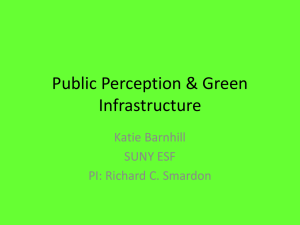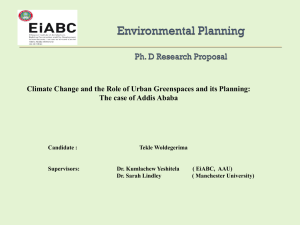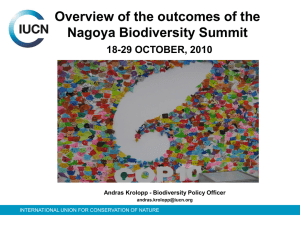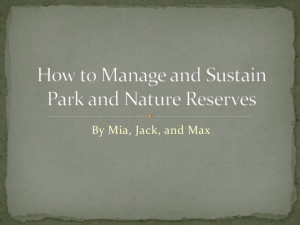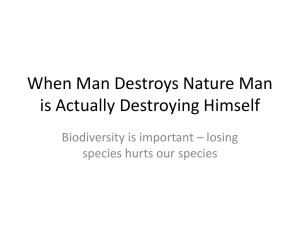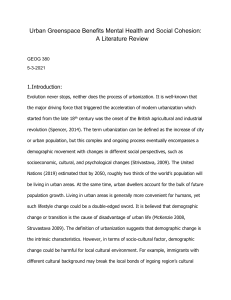The Botanical Biodiversity of Urban Greenspaces
advertisement
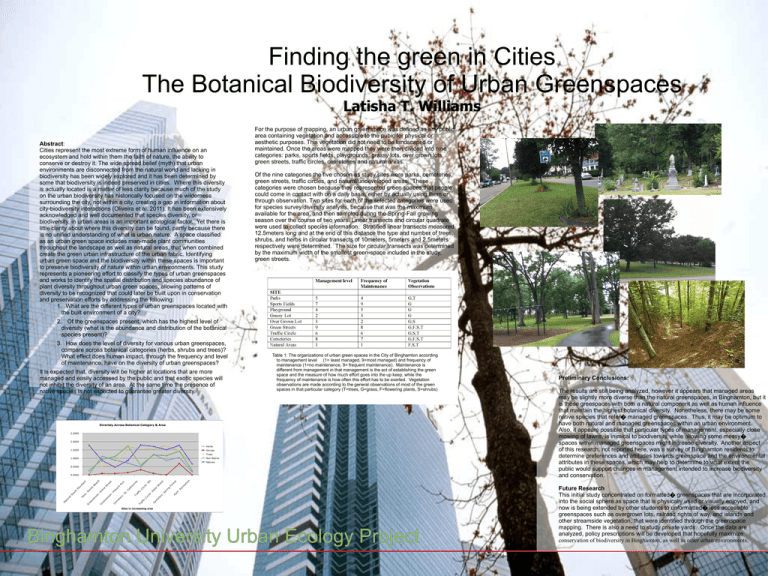
Finding the green in Cities The Botanical Biodiversity of Urban Greenspaces Latisha T. Williams Abstract: Cities represent the most extreme form of human influence on an ecosystem and hold within them the faith of nature, the ability to conserve or destroy it. The wide spread belief (myth) that urban environments are disconnected from the natural world and lacking in biodiversity has been widely explored and it has been determined by some that biodiversity is indeed preserved in cities. Where this diversity is actually located is a matter of less clarity because much of the study on the urban biodiversity has historically focused on the wilderness surrounding the city, not within a city, creating a gap in information about city-biodiversity interactions (Oliveira et al. 2011). It has been extensively acknowledged and well documented that species diversity, or biodiversity, in urban areas is an important ecological factor. Yet there is little clarity about where this diversity can be found, partly because there is no unified understanding of what is urban nature. A space classified as an urban green space includes man-made plant communities throughout the landscape as well as natural areas, that when combined create the green urban infrastructure of the urban fabric. Identifying urban green space and the biodiversity within these spaces is important to preserve biodiversity of nature within urban environments. This study represents a pioneering effort to classify the types of urban greenspaces and works to identify the spatial distribution and species abundance of plant diversity throughout urban green spaces, allowing patterns of diversity to be recognized that could later be built upon in conservation and preservation efforts by addressing the following: 1. What are the different types of urban greenspaces located with the built environment of a city? For the purpose of mapping, an urban green space was defined as any public area containing vegetation and accessible to the pubic for physical or aesthetic purposes. This vegetation did not need to be landscaped or maintained. Once the areas were mapped they were then divided into nine categories: parks, sports fields, playgrounds, grassy lots, over grown lots, green streets, traffic circles, cemeteries and natural areas. Of the nine categories the five chosen as study sites were parks, cemeteries, green streets, traffic circles, and natural/undeveloped areas. These categories were chosen because they represented green spaces that people could come in contact with on a daily basis, either by actually using them or through observation. Two sites for each of the selected categories were used for species survey/diversity analysis, because that was the maximum available for the area, and then sampled during the Spring-Fall growing season over the course of two years. Linear transects and circular quadrate were used to collect species information. Stratified linear transects measured 12.5meters long and at the end of this distance the type and number of trees, shrubs, and herbs in circular transects of 10meters, 5meters and 2.5meters respectively were determined. The size for circular transects was determined by the maximum width of the smallest green-space included in the study, green streets. 2. Of the greenspaces present, which has the highest level of diversity (what is the abundance and distribution of the botanical species present)? 3. How does the level of diversity for various urban greenspaces, compare across botanical categories (herbs, shrubs and trees)? What effect does human impact, through the frequency and level of maintenance, have on the diversity of urban greenspaces? It is expected that, diversity will be higher at locations that are more managed and easily accessed by the public and that exotic species will not inhibit the diversity of an area. At the same time the presence of native species is not expected to guarantee greater diversity. Diveristy Across Botanical Category & Area 2.5000 2.0000 D ive rs ity Herbs 1.5000 Shrubs Trees Non-Native 1.0000 Natives 0.5000 er et em C Sites in increaseing area Preliminary Conclusions: n The results are still being analyzed, however it appears that managed areas may be slightly more diverse than the natural greenspaces, in Binghamton, but it is those greespaces with both a natural component as well as human influence that maintain the highest botanical diversity. Nonetheless, there may be some native species that refer� managed greenspaces. Thus, it may be optimum to have both natural and managed greenspaces within an urban environment. Also, it appears possible that particular types of management, especially close mowing of lawns, is inimical to biodiversity, while allowing some messy� spaces within managed greenspaces might increase diversity. Another aspect of this research, not reported here, was a survey of Binghamton residents to determine preferences and attitudes towards greenspace and the environmental attributes in these spaces, which may help to determine to what extent the public would support changes in management intended to increase biodiversity and conservation. io st at re ec R rk Pa S y- ecl ir C f ic af Tr Fo g in pr ta S f ic af Tr re ee tr S te cl ir C at C t. S y- er et em C t 1 I8 e- n he ri A d ar ow H et re st en re G es . ve t ee tr S na re et re st en G re at N A S rk Pa ur al -S ou th an M dy ou B n ta ea in ch 0.0000 Table 1: The organizations of urban green spaces in the City of Binghamton according to management level (1= least managed, 9=most managed) and frequency of maintenance (1=no maintenance, 9= frequent maintenance). Maintenance is different from management in that management is the act of establishing the green space and the measure of how much effort goes into the up keep, while the frequency of maintenance is how often this effort has to be exerted. Vegetation observations are made according to the general observations of most of the green spaces in that particular category (T=trees, G=grass, F=flowering plants, S=shrubs) Future Research This initial study concentrated on formatted� greenspaces that are incorporated into the social sphere as space that is physically used or visually enjoyed, and now is being extended by other students to unformatted� less accessible greenspaces such as overgrown lots, railroad rights of way, and islands and other streamside vegetation, that were identified through the greenspace mapping. There is also a need to study private yards. Once the data are analyzed, policy prescriptions will be developed that hopefully maximize conservation of biodiversity in Binghamton, as well as other urban environments.


